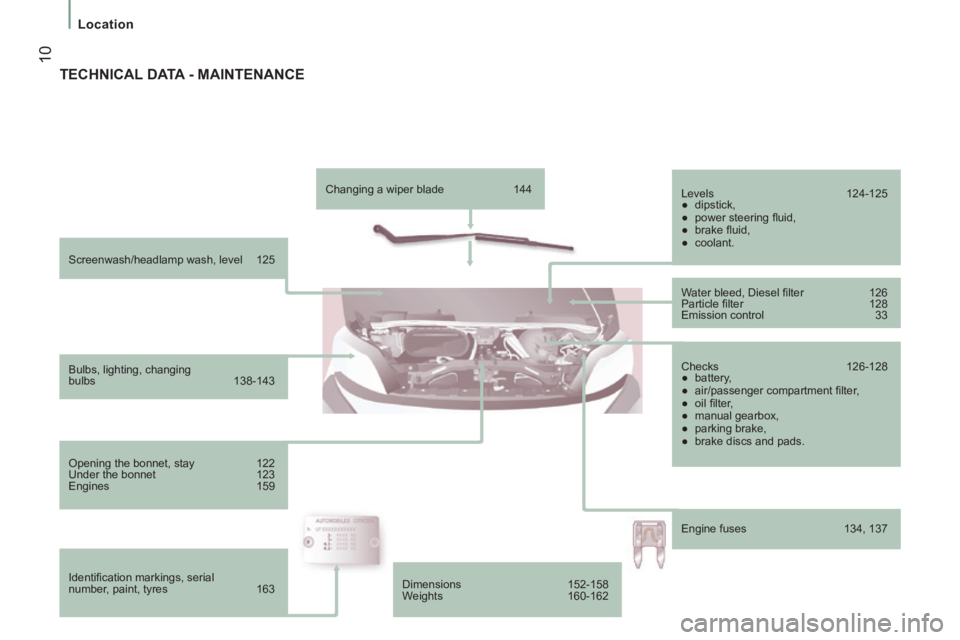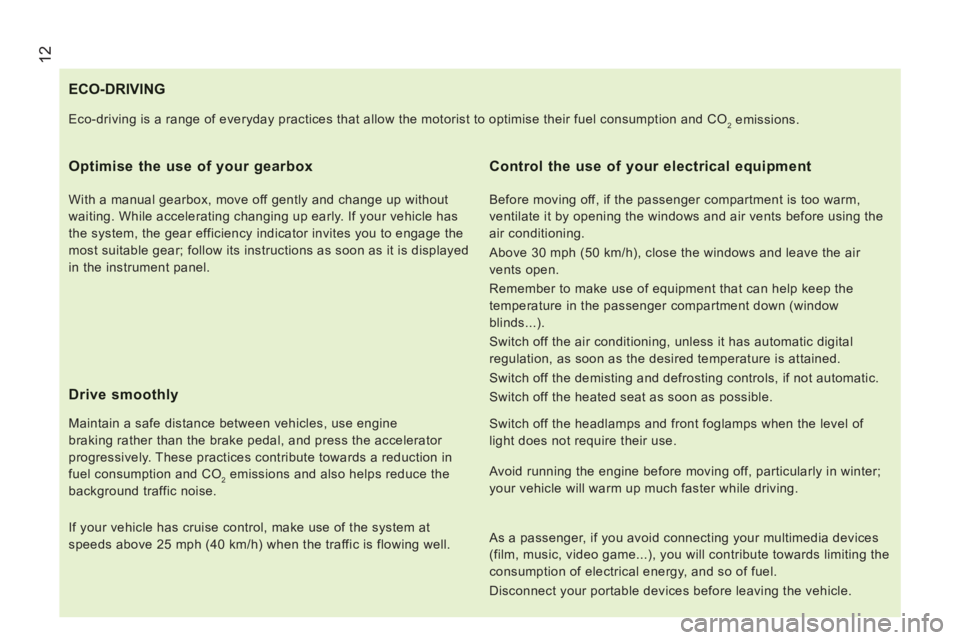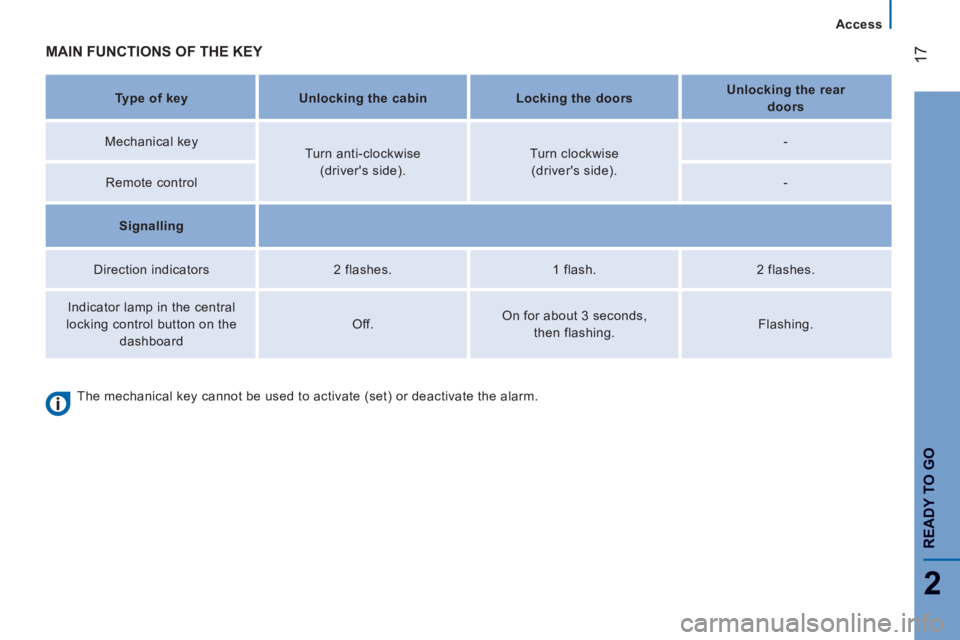CITROEN RELAY 2015 Handbook (in English)
Manufacturer: CITROEN, Model Year: 2015, Model line: RELAY, Model: CITROEN RELAY 2015Pages: 248, PDF Size: 8.86 MB
Page 11 of 248

1
AT A GLANCE
9
Location
Seat belts 102-103
Airbags 105-107
Deactivating the passenger's
front airbag 106, 109
Parking brake, handbrake 95
Front seats, adjustments 69-70
Seat with variable damping 70
2-seat bench 71
Tools, jack 75, 145
Child seats
108-111, 114-115 Rear view mirror
82
Lane departure warning
system 101 Cab courtesy lamp 78-79, 141
Changing a courtesy lamp bulb 141
Courtesy lamps 78-79, 141
12 volt socket 77 Battery (+), charging, starting 131-133
Earth point (-)
123, 131
Fuses in the right hand door pillar 134, 136
INTERIOR
Load space 80-81
● stowing rings,
● load retainer,
● roof box,
● trims,
● 12 volt socket,
● courtesy lamp,
● inspection lamp.
Seats / rear bench seats 72-73
Rear heating /
air conditioning
64-65
Reversing camera 92
Sliding side door
20
Sliding side windows 81
ISOFIX mountings 112-113
Crew cab 74
Accessories 119
Page 12 of 248

10
Location
Screenwash/headlamp wash, level 125
Bulbs, lighting, changing
bulbs 138-143
Opening the bonnet, stay 122
Under the bonnet 123
Engines 159
Identifi cation markings, serial
number, paint, tyres 163 Changing a wiper blade
144
Levels 124-125
● dipstick,
● power steering fl uid,
● brake fl uid,
● coolant.
Water bleed, Diesel fi lter 126
Particle fi lter 128
Emission control 33
Checks 126-128
● battery,
● air/passenger compartment fi lter,
● oil fi lter,
● manual gearbox,
● parking brake,
● brake discs and pads.
Engine fuses 134, 137
TECHNICAL DATA - MAINTENANCE
Dimensions 152-158
Weights 160-162
Page 13 of 248

1
AT A GLANCE
11
Motoring & Environment
ENVIRONMENT
With you, CITROËN acts to protect the
environment.
We invite you to visit the
www.citroen.co.uk website. As the driver, you also can contribute to
protecting the environment by following
certain rules:
- adopt a preventive style of driving,
without frequent and harsh acceleration,
- observe the service intervals; we recommend that services are carried
out by a CITROËN dealer, authorised to
collect used batteries and fluids,
- in order to preserve the reliability of the engine and emission control systems, do
not use engine oil additives. Refer to information on eco-driving at
the end of this section.
Page 14 of 248

12
ECO-DRIVING
Optimise the use of your gearbox
With a manual gearbox, move off gently and change up without
waiting. While accelerating changing up early. If your vehicle has
the system, the gear efficiency indicator invites you to engage the
most suitable gear; follow its instructions as soon as it is displayed
in the instrument panel.
Drive smoothly
Maintain a safe distance between vehicles, use engine
braking rather than the brake pedal, and press the accelerator
progressively. These practices contribute towards a reduction in
fuel consumption and CO
2 emissions and also helps reduce the
background traffic noise.
If your vehicle has cruise control, make use of the system at
speeds above 25 mph (40 km/h) when the traffic is flowing well.
Control the use of your electrical equipment
Before moving off, if the passenger compartment is too warm,
ventilate it by opening the windows and air vents before using the
air conditioning.
Above 30 mph (50 km/h), close the windows and leave the air
vents open.
Remember to make use of equipment that can help keep the
temperature in the passenger compartment down (window
blinds...).
Switch off the air conditioning, unless it has automatic digital
regulation, as soon as the desired temperature is attained.
Switch off the demisting and defrosting controls, if not automatic.
Switch off the heated seat as soon as possible.
Switch off the headlamps and front foglamps when the level of
light does not require their use.
Eco-driving is a range of everyday practices that allow the motorist to \
optimise their fuel consumption and CO
2 emissions.
Avoid running the engine before moving off, particularly in winter;
your vehicle will warm up much faster while driving.
As a passenger, if you avoid connecting your multimedia devices
(film, music, video game...), you will contribute towards limiting the\
consumption of electrical energy, and so of fuel.
Disconnect your portable devices before leaving the vehicle.
Page 15 of 248

13
1
AT A GLANCE
Limit the causes of excess consumption
Spread loads throughout the vehicle; place the heaviest items in
the bottom of the boot, as close as possible to the rear seats.
Limit the loads carried in the vehicle and reduce wind resistance
(roof bars, roof rack, bicycle carrier, trailer...). Use a roof box in
preference.
Remove roof bars and roof racks after use.
At the end of winter, remove snow tyres and refit your summer
tyres.
Observe the recommendations on maintenance
Check the tyre pressures regularly, when cold, referring to the
label in the door aperture, driver's side.
Carry out this check in particular:
- before a long journey,
- at each change of season,
- after a long period out of use.
Don't forget the spare wheel and the tyres on any trailer or
caravan.
Have your vehicle serviced regularly (engine oil, oil filter, air
filter, cabin filter...) and observe the schedule of operations in the
maintenance and warranty guide.
When refuelling, do not continue after the 3
rd cut-off of the nozzle
to avoid any overflow.
At the wheel of your new vehicle, it is only after the fi rst 1 800 miles
(3 000 kilometres) that you will see the fuel consumption settle
down to a consistent average.
Page 16 of 248

14
Access
3-BUTTON REMOTE CONTROL
Unlocking the cab
A short press on this button
unlocks your vehicle's cab.
The interior courtesy lamp comes
on briefly and the direction
indicators flash twice.
A long press on this button opens the
windows (depending on equipment).
The indicator lamp in the central locking
button, located in the dashboard, goes off.
Unlocking the load space
Press this button to unlock
the side door and the rear
doors of the load
space.
The direction indicators flash twice.
If your vehicle has an alarm, pressing this
button deactivates it.
Central locking
Press this button briefly to lock
all of your vehicle's doors, cab
and load space. If one of the
doors is open or is not closed
correctly, the central locking
will not work.
The direction indicators flash once. The
indicator lamp on the control on the centre
console comes on then flashes.
If your vehicle has an alarm, pressing this
button sets it.
A long press on this button closes
the windows (depending on
equipment).
The indicator lamp in the central
locking button, located in the
dashboard, comes on and
flashes.
Page 17 of 248

15
2
Access
READY TO GO
2-BUTTON REMOTE CONTROL
Central unlocking
Pressing this button
simultaneously unlocks all of
your vehicle's doors. The interior
courtesy lamp comes on for a
moment and the direction indicators flash
twice.
If your vehicle has an alarm, pressing this
button deactivates it.
The indicator lamp in the central locking
button, located in the dashboard, goes off.
Central locking
Pressing this button
simultaneously locks all
of your vehicle's doors. If one
of the doors is open or not fully
closed, the central locking does not take
place.
The direction indicators flash twice.
If your vehicle has an alarm, pressing this
button sets it.
The indicator lamp in the central
locking button, located in the
dashboard, comes on and
flashes.
Deadlocking
Press this button twice in
succession to deadlock the
vehicle. It is then impossible to
open the doors from the inside
or the outside.
The direction indicators flash three times.
Folding / Unfolding the key
Press this button to release the
key from its housing.
To fold the key, press the
button then fold the key into the
housing.
Never leave anyone inside the vehicle
when it is deadlocked.
If you do not press the button, there is
a risk of damaging the mechanism.
Page 18 of 248

16
Access
KEY
This locks and unlocks the doors on the
vehicle, opens and closes the fuel filler cap,
as well as starting and stopping the engine.
REMOTE CONTROL BATTERY
Reference: CR 2032/3 volts.
Changing the battery
- Press the button to eject the key.
- Turn the screw 1 from the closed
padlock to the open padlock using a
screwdriver with a thin lip.
- Use the screwdriver as a lever to extract the battery holder housing 2 . - Remove the housing and change the
battery 3 observing the polarities.
- Put the battery holder housing 2 back
inside the key and secure it by turning
the screw 1 .
There is a risk of damage if the
replacement battery is not of the
correct type.
Only use batteries which are identical or of
an equivalent type to those recommended
by a CITROËN dealer. Take used batteries
to an authorised collection point.
Page 19 of 248

17
2
Access
READY TO GO
MAIN FUNCTIONS OF THE KEY
Type of key Unlocking the cabin Locking the doors Unlocking the rear
doors
Mechanical key Turn anti-clockwise
(driver's side). Turn clockwise
(driver's side). -
Remote control -
Signalling
Direction indicators 2 flashes. 1 flash. 2 flashes.
Indicator lamp in the central
locking control button on the dashboard Off.
On for about 3 seconds,
then flashing. Flashing.
The mechanical key cannot be used to activate (set) or deactivate the \
alarm.
Page 20 of 248

18
Access
ELECTRONIC IMMOBILISER
All of the keys contain an electronic
immobiliser device.
This device locks the engine supply system.
It is activated automatically when the key is
removed from the ignition. Operating the remote control, even when it
is in your pocket, may result in involuntary
unlocking of the doors.
However, if none of the doors is opened
within approximately thirty seconds following
unlocking, the doors relock automatically.
The simultaneous use of other high
frequency equipment (mobile telephones,
domestic alarms…), may interfere with the
operation of the remote control temporarily.
The remote control does not operate while
the key is in the ignition, even if the ignition
is off, except for reinitialisation.
Good practice
Make a careful note of the number of the
keys. If they are lost, your CITROËN dealer
will be able to carry out his work more
quickly and effectively if you give him this
number and the confidential card.
Do not make any modifications to the
electronic immobiliser system. This warning lamp is switched off
after the ignition is switched on
and the key has been recognised,
the engine can be started.
If the key is not recognised, the engine
cannot be started. Use another key and
have the faulty key checked by a CITROËN
dealer.
Driving with the doors locked may make
access to the passenger compartment
by the emergency services more diffi cult in an
emergency.
As a safety precaution (with children on board),
remove the key from the ignition when leaving
the vehicle, even for a short time.
After the ignition is switched on, a dialogue
is established between the key and the
electronic immobiliser system.
When purchasing a second-hand vehicle:
- ensure that you are given the confidential card,
- have the keys memorised by a CITROËN dealer to ensure that the keys
in your possession are the only ones
which can start the vehicle.
CONFIDENTIAL CARD
This is given to you on delivery of your
vehicle with the duplicate keys.
It contains the identification code necessary
for any work carried out by a CITROËN
dealer on the electronic immobiliser system.
This code is hidden by a film, which should
be removed only if necessary.
Keep your card in a safe place, never inside
the vehicle.
When undertaking a long trip or journey,
however, it is advisable to take it with you
along with your personal papers.